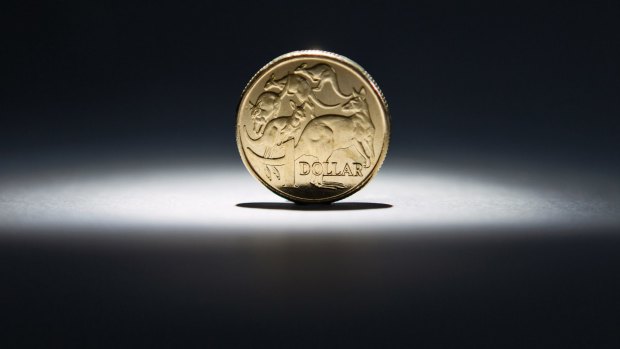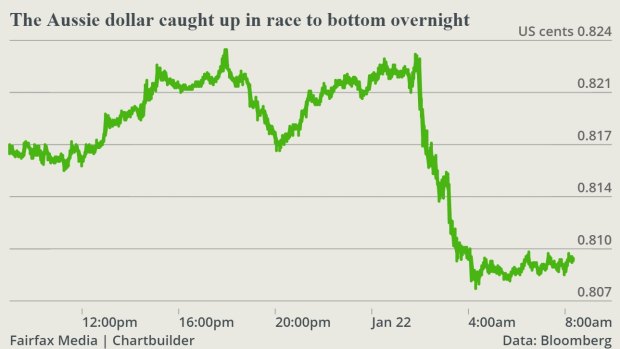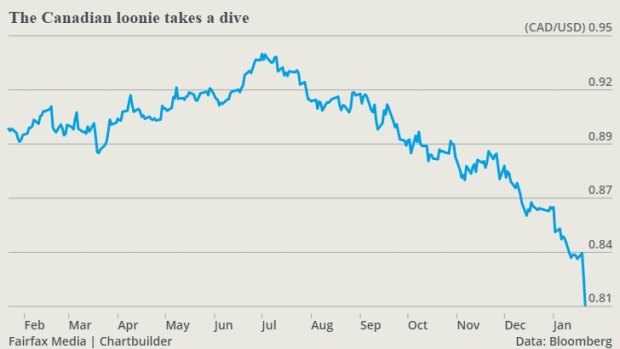This was published 9 years ago
Australian dollar dives below 81 US cents on Canada rate cut, ECB talk
By Bianca Hartge-Hazelman
The Australian dollar dropped anew below US81¢ after the Bank of Canada made a surprise rate cut, its first in almost six years, and amid reports the European Central Bank (ECB) plans a bigger-than-expected stimulus package to revive struggling growth and stem a downward spiral in prices.
The local currency fell about US1¢, or 0.95 per cent, to US80.81¢, down from US82.13¢ on Wednesday after the Bank of Canada pared back its overnight lending rate by a quarter of a point to 0.75 per cent.

The local currency fell about one cent on reports the ECB will unveil a €1.1 trillion stimulus scheme.Credit: Bloomberg
Saying that the collapse in oil prices will slow inflation and weigh on the domestic economy, BoC Governor Stephen Poloz said the bank "has room to manoeuvre should its forecast prove to be either too pessimistic or too optimistic". The decision sent the Canadian dollar into a tailspin, falling to a six-year low of C80.7¢ against the greenback.
The surprise move lifted expectations the Reserve Bank of Australia would follow suit and cut the cash rate as early as next month. Markets are now tipping a 40 per cent chance the RBA will cut the cash rate by 25 basis points to 2.25 per cent when it meets on February 3, that's up from an 18 per cent probability yesterday, according to NAB.

European and Asian shares also got a further boost to build on this weeks gains as details emerged that ECB President Mario Draghi and his executive board proposed spending hefty €1.1 trillion ($1.57 trillion) or €50 billion a month until December 2016 to help revive economic growth.
The money, or quantitative easing (QE) package, will be announced later today in Europe and is expected to take shape via a bond-buying program. It still needs to get the go ahead from the ECB's governing council.
QE has become a popular term in the years after the 2008 financial crisis. It is a type of monetary policy used by central banks in which they create new money by buying assets, typically bonds to help stimulate their respective economies.
National Australia Bank head of research for the UK and Europe Nick Parson said the biggest bang for the buck (or the euro) will come if the QE programme is big, quick and driven by the ECB.

"Size matters. To get to get the balance sheet up to 2012 levels would imply buying assets worth €1 trillion in total, comprising around €100-200 billion of Covered Bonds and ABS, €300-400 billion of TLTRO lending and the remainder by sovereign and or corporate bond buying. €500-600 billion should be an absolute minimum. Time is of the essence too. The sooner the programme starts, the quicker its impact can be felt."
Europe's unemployment rate is 11.5 percent and growth is less than 1 per cent. Deflation is a real threat as that is where prices decline and consumers lose further confidence in spending.
Aussie shares are also expected to gain when the local market resumes trading at 10am AEDT, with the SPI Futures up 0.5 per cent following strong leads from European and Asian markets, a mixed result from Wall Street and a stronger oil price.
Other central bankers were also on the front foot as the Bank of Canada unexpectedly cut its main interest rate for the first time since 2009 on the basis that the plunging oil price , which has halved in value over the past six months, could slow inflation.
Brent crude oil, the international benchmark, gained about 2 per cent on Wednesday night and is trading at $US48.99 a barrel.
The Bank of Japan also expanded and extended a lending program, and two Bank of England policy makers abandoned their calls for higher interest rates on the basis that the economy is not quite ready for it.
The return of a risk-on mode in markets saw gold take a dip, down 0.13 per cent to $US1292.5 an ounce, but earlier the precious commodity has climbed above $1300 an ounce for the first time since August.
Fears about European deflation and expectations of increased volatility this year have been supportive of the gold price.